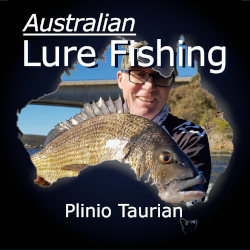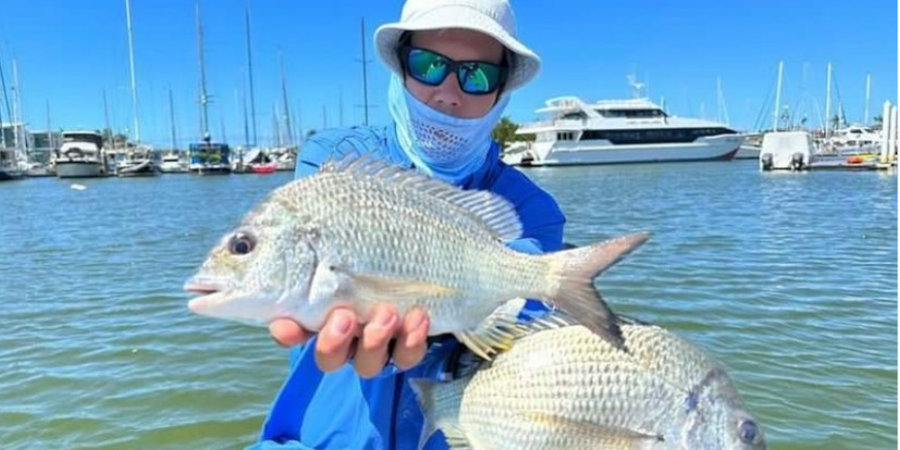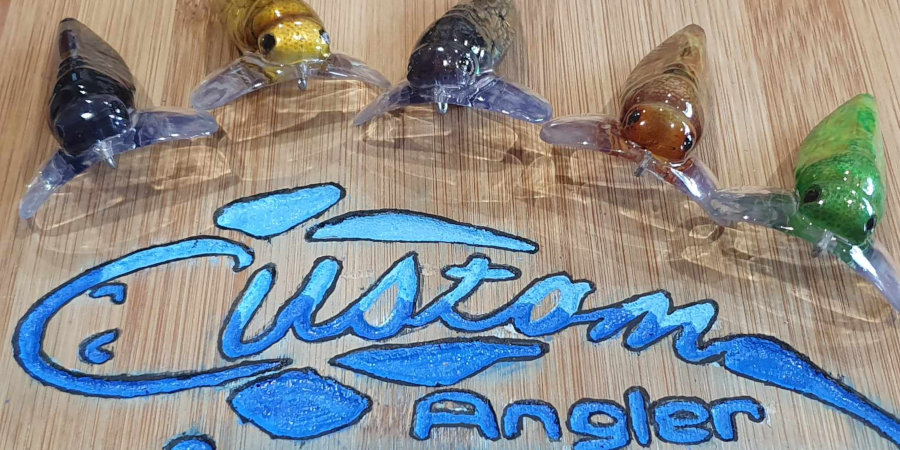
Russell’s Forster Bream Fishing Tips
- Bream can be targeted year-round when fishing at Forster, although Russell prefers May for the really big fish, which congregate in the lower reaches of the estuary at that time in preparation for spawning. They thin out during the winter but start to come back in July/August and are lean and hungry, making them easy to catch.
- During September the fish start to scatter through the system, making it pretty hard to pinpoint where the fish will be.
- Forster bream fishing is characterised by big fish, clear water and plenty of heavy structure. During July-September it’s all about fishing the bridges, rock walls, oyster leases and occasionally flats down at the bottom end of the system.
- On a run-in tide Russell likes the rock walls, bridges, flats and shallow ground where the fish move up onto structure with the rising water. On the last of the runout tide (Russell’s favourite) when there’s not much water the fish are limited as to where they can be – look for structure such as a bridge that’s near a flat that the fish have retreated from with the falling tide. The poles at the top and bottom of oyster leases also have holes that fish often retreat into.
Russell’s Bream Tackle
- Russell prefers slightly heavier gear for Forster bream fishing and typically uses rods rated from 2-5 kg up to 3-6 kg, with 8lb braid and 8 lb leader or 10 lb braid and 10 lb leader. Reel size is important because in this heavy structure it’s necessary to keep that fish moving towards you as fast as possible, so it doesn’t have a chance to get back into structure.
Russell’s Forster Bream Fishing Lures
- 2” Gulp Camo Crabby is a staple for Forster Bream Fishing and is fished by casting it super tight to cover and waiting for it to get hit as it sinks to the bottom. This is fished on a 1/24oz Berley Nitro hook in size 4 most of the time. This makes the lure sink headfirst with the claws up. Once it’s on the bottom it is best to give it a couple of shakes and then crank back and cast again, as nine times out of ten the bite comes on the drop.
- A 3” Gulp Minnow can be worked a fair bit faster than a Crabby, allowing the angler to cover a fair bit more water in search of fish. This is rigged on a 1/24oz Berkley Nitro jig head when fishing structure or 1/16oz jig head when Russell wants to cover more ground and work the lure with a faster, more erratic action.
- A 2” Berkley Gulp Shrimp rigged unweighted on a weedless an Owner #1 worm hook is useful at the top of the tide when fish are right on top of oyster racks. Skip it across the surface and then let it sink as slowly as possible and the fish will often charge out and smash it.
- A deep diving hard body such as an Oar-Gee Lil Ripper or JP Runt in black/purple is a great searching lure for rock walls and bridge pylons (fish the shallowest side). These are worked in ways that they crash into the structure, the bib keeping the hooks safe from snagging. Running parallel and in the shadow of structure works well – remember that fish always face into current, so cast up-current and work the lure back. Deep divers can also be worked through shallower water simply by winding slower with plenty of pauses and rod tip twitches.
- Russell rarely throws grubs when he’s Forster bream fishing, but occasionally a Gulp Nemesis gets a cast or two. He rigs these weedless, but on a standard jig head, going up in hook size to 1 or 1/0 with a 1/8 or 1/6 oz head. To rig, feed the jig head through the front of the lure for 5-6mm and twisting the lure around to rig it in much the same way as you would on a worm hook. Being a slim profile lure, the nemesis rigged in this way squashes down and allows the fish to get easily hooked when it bites down.
Russell Babekuhl
Australian Hobie Champ 2022
Russell is an accomplished tournament angler, and although we’ve listed him above as the 2022 Australian Hobie Tournament Champ that’s just the latest in a long line of accolades that stem back over a decade and are to numerous to mention here. Russell grew up in Wingham, NSW, which means that fishing at Forster is how he cut his teeth with lures – and he still counts it as one of his favourite fishing destinations.

Fishing In Hobart: A Bream Masterclass With Plinio And Deathy
Check out a swag of little known techniques and insights for fishing the Derwent River system for bream in this awesome interview with Plinio Taurian.

Fishing At Forster: 5 Top Spots With Local Gun Luke Austin
The fishing at Forster – Tuncurry is superb, all year round with numerous options for land-based and boating anglers alike. Luke Austin has lived there all his life and shares some great spots for visiting anglers and locals alike.
Unveiling the Secrets of Tuggerah Lake Fishing: Adam Amos on Bream
Tuggerah Lake Fishing is EPISODE 668. Check out our archives for more information on Bream Fishing!Introduction to Tuggerah Lake Fishing Tuggerah Lake, nestled on the NSW Central Coast, is a prime destination for bream fishing, easily accessible from Sydney. It's a...

Ben Monforte’s Revolutionary Approach to Moreton Bay Bream Fishing
Ever considered using Japanese Free Rigging techniques to target bream? That’s exactly what today’s guest Ben Monforte shares with us in a fascinating techniques-based interview.

On Yamba Bream, Pimping Lures and the WRFL With Laurie Anderson
Yamba can be an exceptional fishing spot – and bream are high on the list of targets for many anglers. Tournament fisho and lure customiser Laurie Anderson shares her tips and advice in this episode.

Fishing In Hobart: A Bream Masterclass With Plinio And Deathy
Check out a swag of little known techniques and insights for fishing the Derwent River system for bream in this awesome interview with Plinio Taurian.

Fishing At Forster: 5 Top Spots With Local Gun Luke Austin
The fishing at Forster – Tuncurry is superb, all year round with numerous options for land-based and boating anglers alike. Luke Austin has lived there all his life and shares some great spots for visiting anglers and locals alike.
Unveiling the Secrets of Tuggerah Lake Fishing: Adam Amos on Bream
Tuggerah Lake Fishing is EPISODE 668. Check out our archives for more information on Bream Fishing!Introduction to Tuggerah Lake Fishing Tuggerah Lake, nestled on the NSW Central Coast, is a prime destination for bream fishing, easily accessible from Sydney. It's a...



0 Comments